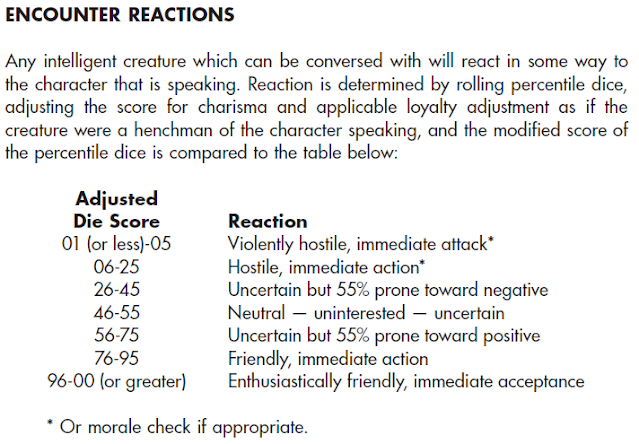This is an interesting question.
I think the first point to consider is that, regardless of the mechanical method you use to introduce “mechanical spread” (in the numbers, using dice) on your reaction rolls, the amount of actual “narrative spread” (in the story possibilities, using your imagination and interpretation) you will introduce as a result depends upon which old-school reaction table you are choosing to consult. The classic Moldvay basic (BX) rules used 2D6 on a table slightly skewed toward negative reactions in its bell curve, with “hostile” monsters in mind as the standard encounter.
Conversely, Gygax’s AD&D 1e reaction table was a perfectly balanced D100 lookup, more universal in nature to be used for the typical NPC going about his business as well as for monsters.

IIRC I believe 2e even had a secondary D20 refinement matrix to suggest action based on the result of your initial (2D6) reaction roll. That’s a lot of crunch (even for me…).
Whatever reaction roll scheme you decide, it may be useful to consider the nature and magnitude of any skew it may have.
Second, I like the conceptual refinement you are suggesting, adding heterogeneity to the aggregate reaction of a group of monsters to create better verisimilitude—even if may receive some perfectly understandable pushback as part of the discussion. (See my recent proposal concerning automatic firearms mechanics in ICRPG.) I think the cost-benefit analysis of your idea could be favorable because it clearly opens up more roleplaying opportunities on each encounter, especially if your mechanical implementation is simple and smooth.
I think the easiest way to implement your “reaction spread” concept is to use a D6 (or maybe a D4 or D8) and use one additional roll of this die to determine the magnitude of disagreement in any size group of monsters (regardless of actual creature quantity). For example, as a secondary roll modifying the old-school 2D6 reaction table, assign even numbers result values of +1, +2, and +3 to the initial 2-12 reaction, and then make odd numbers map to -1, -2, and -3 modifiers. So if you roll a 4 “Monster growls” on the initial 2D6 roll, most of the monsters in the group take an aggressive stance, poised for battle and ready, but the do not charge in; then, the secondary “reaction spread” D6 roll would give you a 50% chance (any odd result) that at least some of the monsters would attack immediately and a 16.7% chance (when the result maps to +3) that at least some of the monsters will hang back even if the growling mass is provoked into combat.
There are so many ways to accomplish what you suggest mechanically, and I think your concept remains valuable and sound at a lot of tables. I think that respecting and reflecting “the spirit of the law” in the ICRPG philosophy is to search for and exploit the “significant math” in the mechanical problem you have laid out to solve, keeping your solution mechanic simple and intuitive so that the granularity you introduce is meaningful and beneficial to your game.
Good luck.

